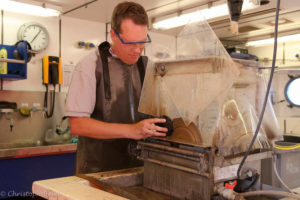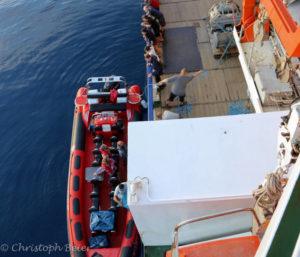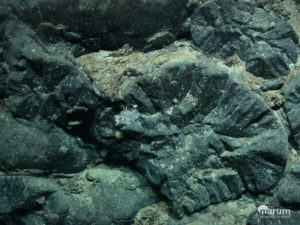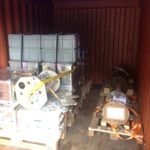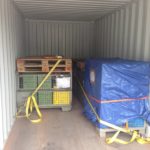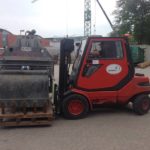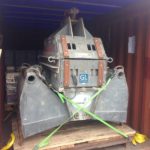Azoren Plateau, 2016 – FS Meteor – Ausfahrt M128
FS Meteor – Cruise M128 Azoren Plateau
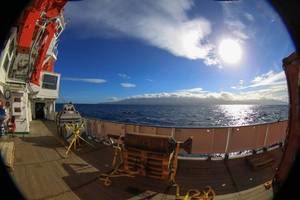 The Azores are a group of islands consisting of a large number of young and partially active volcanoes. The volcanic islands lie on the Azores Plateau, an area of thickened oceanic crust that is thought to have been formed by massive submarine volcanism 5 to 10 million years ago. The objective of cruise M113 is to investigate the volcanic and tectonic structures of the Azores Plateau with seismic methods, to survey the plateau for the first time with multibeam echosounders and to take rock samples on the Azores Plateau. Scientists from GZN are on board to study the rock samples and, together with geophysicists from the University of Hamburg, to develop a model for the causes of the extensive volcanism of the Azores.
The Azores are a group of islands consisting of a large number of young and partially active volcanoes. The volcanic islands lie on the Azores Plateau, an area of thickened oceanic crust that is thought to have been formed by massive submarine volcanism 5 to 10 million years ago. The objective of cruise M113 is to investigate the volcanic and tectonic structures of the Azores Plateau with seismic methods, to survey the plateau for the first time with multibeam echosounders and to take rock samples on the Azores Plateau. Scientists from GZN are on board to study the rock samples and, together with geophysicists from the University of Hamburg, to develop a model for the causes of the extensive volcanism of the Azores.
Publications related to M128
- Romer, R., Beier, C., Haase, K.M., and Hübscher, C., 2018. Correlated changes of volcanic structure and magma composition in the Faial volcanic system, Azores. Frontiers Earth Science 6:78. doi: 10.3389/feart.2018.00078.
- Romer, R.H.W., Beier, C., Haase, K.M., Klügel, A., and Hamelin A., 2019, Progressive changes in magma transport at the active Serreta Ridge, Azores. Geochemistry, Geophysics, Geosystems 20,5394-5414. Doi: 10.1029/2019GC008562.
- Beier, C., Bach, W., Busch, A.V., Genske, F.S., Hübscher, C., and Krumm, S., 2019. Extreme intensity of fluid-rock interaction during extensive intraplate volcanism. Geochimica et Cosmochimica Acta257, 26-48.
- Storch, B., Haase, K.M., Beier, C., Romer, R.H.W., and Koppers, A.A.P., 2020. Rifting of the Azores Plateau by alternating magmatic and tectonic phases. Scientific Reports 10, 19718, doi: 10.1038/s41598-020-76691-1.
- Romer, R.H.W., Beier, C., Haase, K.M., Eberts, A., and Hübscher, C., 2021. The evolution of central volcanoes in ultraslow rift systems: constraints from Dom Joao de Castro seamount, Azores. Tectonics
Press reports of our expedition
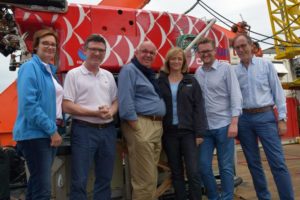
- Bundesministerium für Bildung und Forschung
- Deutsche Forschungsgemeinschaft (DFG)
- Marum, about the visit of a delegation of the German parliament Bundestages, BMBF, DFG and 30 years of FS Meteor
3. weekly report 27. Juli 2016
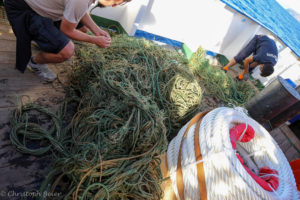
The third week of cruise M128 started after a short transit from Ponta Delgada with some TV grab stations and a dive west of São Miguel Island. It turned out that this area, located directly in the Terceira Rift, was probably not affected by historical eruptions, because the rocks are older and also the strong occurrence of marine faunas indicates that there was obviously no volcanism in our dive area in historical times. In addition, the quick and good reaction of the deck and ROV crews saved us from greater damage during this dive, because due to the proximity to the island of São Miguel and the relatively rough topography, this region is virtually contaminated by fishing nets floating in the water and lying on the bottom. In the last hour of the dive, apparently large amounts of younger and older fishing lines had wrapped themselves around the wire of the ROV, so that we were all finally very glad that no damage had occurred to the ROV.
During the night, rocks were then bored northwest of São Miguel in five TV grab stations, showing that there is no evidence of historic volcanism in the area of the northern rift shoulder either. The hypothesis is now solidified that recent volcanism in the Azores is exceedingly localized and very small-scale, and that tectonic structures dominate volcanism in the region today.
The following dive on Tuesday then took place 20 km southwest of São Miguel, but in a water depth where no fishing lines were expected. During this dive we saw and sampled spectacular geological outcrops with lava flows, pillow lavas and possibly veins. We used the night of the belated mountain party, where the crew and scientists on board traditionally celebrate the halfway point of an excursion, to travel to the southern part of the Azores Plateau, where we made a dive along the East Azores Fracture Zone the following day. The rocks brought on board by the diving robot were quite unexpected and excited the geologists. The samples were strongly altered mantle peridotites, which we had not expected to find at 2500 meters water depth, but almost 1500 meters above the surrounding ocean floor. The following day, we took the opportunity to drop off some more TV grabs to get our hands on even more sample material. This also gave the ROV crew time to work on a technical problem with the ROV winch that had crept in over the last few days. The next day then offered another spectacular geological dive at Princesa Alice Bank, about 40 nautical miles south of Faial Island, where we had an impressive dive through the exposed crustal rocks that yielded a variety of samples of veins and pillow lavas.
Our plan to dive the next morning near the young volcano Capel- inhos near Faial, which was active from 1958-1959, was unfortunately complicated by the fact that during the night we had again recovered a frighteningly large fishing net with the TV grab in the immediate vicinity of the planned dive site. It makes us all think that in these areas the sea is apparently so heavily polluted. Therefore, the dive location was moved a little further southwest to safer terrain before we then recovered more great samples of capelinhos during the night with the TV grab. All this happened within sight of the Dutch research vessel Pelagia, which has also been working here for a few days. A short visit was made by the colleagues of the University of the Azores in Horta, who came alongside in a rubber dinghy to bring the cooled biological sample material ashore by the shortest route.
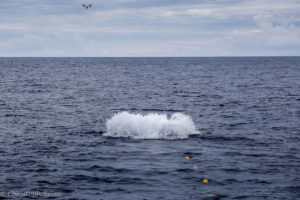
Another dive completed the strati- graphical profile at Princesa Alice Bank with more spectacular samples indicating intense reactions with hot seawater, thus exciting the colleagues from Bremen. The destination of the last dive and the last five grab stations on Monday was then the western foothills of São Jorge Island, where the geological sampling of the Azores plateau ended on Tuesday morning at 02:00.
The last hours are now spent cleaning up the labs, packing the samples and containers, and making the final preparations to enter Ponta Delgada. During the M128 cruise, we made 19 ROV dives, ran 70 TV grabs, and hydroacoustically mapped 2000 nautical miles for a total cruise distance of 3967 km. More than 350 rock samples and more than 400 biological samples have been collected. We all agree that this would not have been possible without the crew of the FS Meteor under Captain Jan F. Schubert and thank them for the helpful, friendly and familiar atmosphere on board, which made this work possible in the first place!
2. weekly report 16. Juli 2016
During the second week of cruise M128 Azores Plateau, we continued our work at the young, active Serreta volcano west of Terceira Island. The last eruptions were observed here from 1998-2001. The eruptions of this submarine volcano, which is located in a water depth of 300-400 m about 5 nautical miles west of the island, have become known due to lavas that drifted for a short time on the surface for a short time before sinking back into the depths. This is attributed to the gas-rich compositions of the melts and quenching in seawater, which apparently leads to the formation of lava balloons that have enough buoyancy for a short time to float on the sea surface. Since little bathymetric and geologic information has been available on this eruption, three highly successful ROV dives and 8 TV grabs were made here, yielding a total of 67 fresh, mostly glassy rock samples. For biologists, too, these young volcanoes offer a unique opportunity to study the colonization of these young lava flows in more detail. It turns out that the corals growing here, with a growth rate of about 1 cm per year, have a size of about 10-15 centimeters in wide areas of the eruption, which the geologists on board can also use as an indirect dating possibility. We had already tried to work here last week, but unfortunately our diving area was occupied by fishermen and nets, so that the intervention of our Portuguese colleagues was necessary to close the area to fishing for a few days. Fortunately, the Azores authorities were very quick and flexible, so that the fishing had moved a few nautical miles out of our working area. Unfortunately, however, not all fishermen complied, so we spent some time on Sunday and Monday radioing the fishermen and asking the authorities ashore to contact the boats.
In addition, we have been able to produce a detailed map with the EM 710 hydroacoustic sounder, which has already significantly increased the geological understanding of this young eruption, on board. Thus, colleagues from Erlangen, Bremen, Münster and Munich are extremely excited about the rocks. One finding of our work is that the Serreta volcano apparently does not consist of a series of small eruption craters, but was formed from a rift system on whose faults the magmas rose. In total, the recent volcanic activity in the Azores extended over a length of almost 3.7 km and a width of 300m.
During the rest of the week, from Tuesday to Thursday morning, we spent most of our time in a hydroacoustic profile. We headed towards the Mid-Atlantic Ridge, which is located 140 km west of the island of Graciosa. The goal of this mapping is to find out where the plate boundary is between the Eurasian, African and American plates.
The maps processed by the two colleagues from Hamburg show that the interlocking of the Terceira Rift and the Mid-Atlantic Ridge is tectonically more complex in this region than was previously known. The attempt to get some samples from the volcanoes 40 km east of the Mid-Atlantic Ridge failed due to the hard rocks, where our TV grab can’t attach properly, but also due to a technical problem with the hydraulic system, which the team around our technician Bernd Schleifer is working on intensively. On Thursday we had the opportunity to do a ROV dive west of the island of Graciosa. The rocks and images taken by the ROV showed us that the rift movements west of Graciosa Island are obviously amagmatic, which distinguishes it significantly from the other Azores islands. Continuing a stratigraphic profile that we had started at the beginning of the cruise gave us terrain that was challenging for the ROV pilots in terms of flying, with submarine walls that were several tens of meters high in places. At the end of this dive, we can now draw on the video footage and 32 rock samples from a 2 kilometer high outcrop in our future work, which would be much more difficult to accomplish on land.
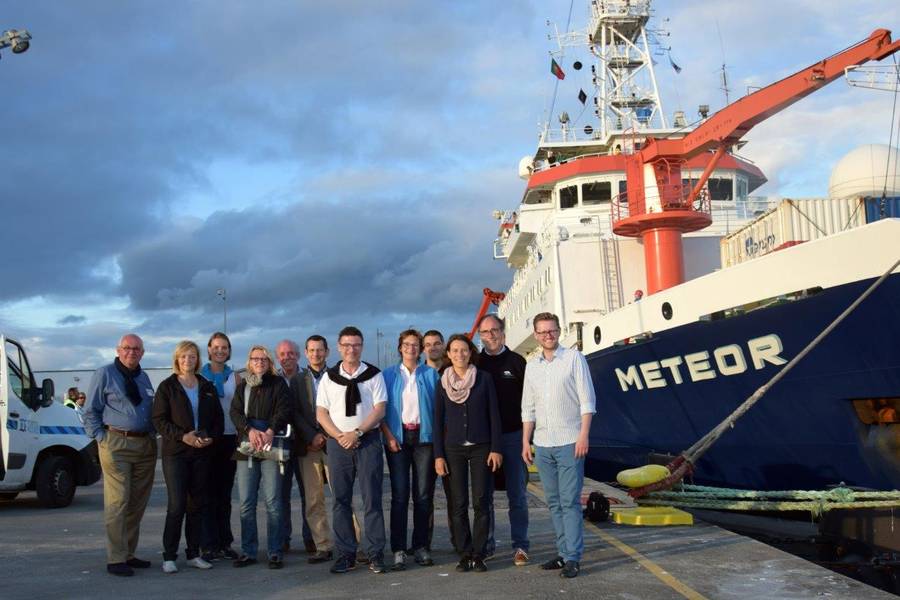
The night to Sunday we lay in the port of Ponta Delgada where two highlights awaited us on Sunday morning. On the one hand the 400th dive of the ROV Quest 4000 from the Marum – Center for Marine Environmental Sciences in Bremen, on the other hand the visit of a
Delegation of the German Research Foundation, the Federal Ministry of Education and Research, the Project Management Agency Jülich, members of the German Bundestag and the German Research Vessel Control Center in Hamburg to celebrate the 30th birthday of FS METEOR. On the occasion of this round birthday we had the opportunity to highlight the nautical and technical as well as the scientific aspects of our work. The dive west of the island of São Miguel showed us that the volcanism in this area, similar to what we have already seen at Terceira, occurs very locally and not in a larger area as previously assumed. For all scientists on board, this pleasant and exciting visit was a special occasion, as we do not often have the opportunity to present our work on board. So the delegation could also witness our TV grab doing its job again during a test on deck. In the end it was probably only a defective sealing ring, which is now replaced, so that nothing stands in the way of its use. On Sunday evening we sailed again towards Ponta Delgada, where FS METEOR left after a quick group photo in front of the bow.
All on board are well and the weather continues to be kind to us, we have little wind and only a small swell.
Im Namen aller Fahrtteilnehmer grüßt,
Christoph Beier, Auf See, 37°55N / 25°52W
1. weekly report 10. Juli 2016
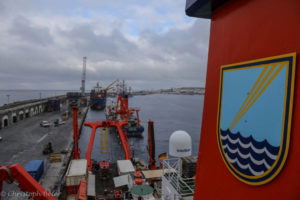
The 27 scientists on board cruise M128 come from the Geological Survey of Portugal and the University of the Azores in Horta on Faial, as well as from the universities of Erlangen-Nuremberg, Bremen, Münster, Munich and Hamburg, and are composed of geologists, volcanologists, geophysicists, and biologists who are working together to understand the processes that lead to the formation of large, submarine oceanic plateaus.
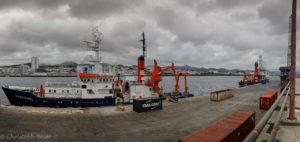
The goal of the cruise is to understand the processes that lead to the formation of such large oceanic plateaus as the Azores and play a role in their evolution. We will use the autonomous diving robot (ROV) from the Marums in Bremen, Germany, to perform stratigraphic sampling of the older plateau lavas as well as detailed sampling of the youngest volcanic cones.
sample. This unique opportunity we have here will hopefully contribute significantly to our understanding of how these bathymetric anomalies form. Another major focus will be the hydrothermal activity known at the submarine volcano João de Castro 40 nautical miles west of São Miguel. Here we have a unique opportunity to sample fluids that occur at intraplate volcanoes. These occurrences are so far only known from Loihi on Hawaii and we hope to gain insight into how the fluids that emerge differ from those of a mid-ocean ridge.
We will use the video-guided grab and a gravity corer during this cruise. At the core of our work, however, will be the QUEST 4000 ROV, which, with its high-resolution cameras and sampling equipment, offers the unique opportunity to see how and where samples are taken.
The cruise started at 9 am on July 2, 2016 with departure from Ponta Delgada, and due to the fact that we were already in the working area, the scientific hydroacoustic recordings started already at 9:20 am to get a more accurate map of the seafloor. At 12 noon, a bathymetric profile was run specifically, with colleagues from Hamburg and Bremen trying to see if hydrothermal gas bubbles could already be detected from the hydroacoustic data. Already in the afternoon, the first two video-guided grab samples were successfully taken and during the following night we sailed Multibeam towards João de Castro, a small volcano located about 50 nautical miles northwest of São Miguel. There we drove further multibeam profiles in the morning, where Wolfgang Bach from the University of Bremen had possibly already found first indications of hydrothermal activity. We spent the day in the best weather with further grab sampling, all of which was very successful and yielded plenty of sample material for the petrologists and geologists on board. On Sunday 03.07.2016, the TV grab was successfully deployed on five stations, giving us information on which areas of the João de Castro seamount are active. We also used the night to Monday for hydroacoustic mapping east of Terceira Island, where we can already clearly make out the extensional movements in these areas in the bathymetric data.
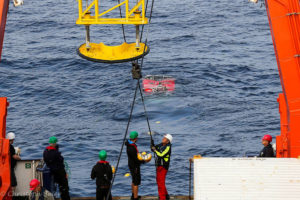
On Monday, the time had finally come for the first dive with the Bremen ROV QUEST 4000 and the scientists on board watched with great excitement as the ROV and the deck crew of the Meteor brought the device into the water. We
had chosen this area of the volcano for the dive because hydrothermal activity had already been described here.
Unfortunately, we did not find the described hydrothermal vents, but the dive was extremely successful with 12 rock samples and, together with the grab samples, will give a detailed picture of the evolution of this intraplate volcano, which is also located in a slowly spreading rift.
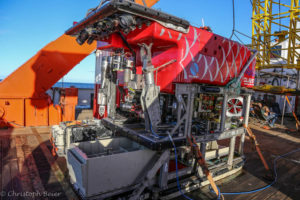
During the night, the grab was successfully deployed again before we moved about 10 nautical miles to the north, where on Tuesday we successfully carried out stratigraphic sampling of a steep face more than 1300 m high. A complete success, because
the ROV came back in the evening with 13 rock samples and two biological samples, one of which might be a new species. The two biologists from the University of the Azores in Horta are enthusiastic about the samples brought on board by both the ROV and the TV grab and are busy cataloging and preserving their material.
In the night to Wednesday we could finally locate with the TV grab where the youngest volcanism is located at this seamount. There we dived on Wednesday, a great geological dive in the middle of young basaltic lava flows, pillow lavas and lapilli fields. The samples we obtained are scientifically unique and show, together with the
other rock samples at this seamount, how diverse and variable the rocks of submarine volcanoes can be, but also that volcanic activity here appears to be very localized in recent times along a young rift zone. We spent the rest of the night on our way to Serreta, one of the most recent eruptions in the Azores.
However, at our originally planned dive point there were numerous fishermen and buoys with longlines in the morning, which did not allow a safe deployment of the ROV, so we had to decide with a heavy heart to continue The ROV Quest 4000 after successful deployment on deck.
Since Saturday morning, with low swell and little wind, we are now underway northwest of Terceira, running an ROV profile that is essentially about sampling the oldest lavas on the platform. Thanks to the efforts of our biologists from the University of the Azores in Horta, we have managed to establish an exclusion zone around Serreta, where we hope to be able to work safely on Sunday and Monday.
Everyone on board is doing well, the weather is currently good for us both in terms of swell and wind conditions and this should continue for the coming week.
Im Namen aller Fahrtteilnehmer grüßt,
Christoph Beier
Auf See, 39°N / 27°W
Loading the container
End of Mayi: the containers are loaded at Geomar in Kiel with the pre-packed material from Erlangen, Hamburg and Kiel.
Pack- und Verladeaktion Erlangen
Research material, computers, sample containers, private and work clothing: everything is packed seaworthy in Erlangen and sent by truck to Kiel. There it is packed into containers with other material and shipped in advance to the Azores.

